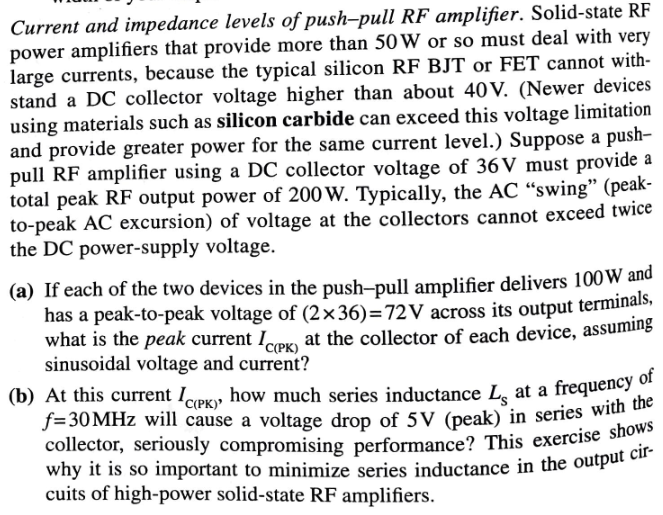Current and impedance levels of push-pull RF amplifier. Solid-state RF power amplifiers that provide more than 50 W or so must deal with very large currents, because the typical silicon RF BJT or FET cannot with- stand a DC collector voltage higher than about 40V. (Newer devices using materials such as silicon carbide can exceed this voltage limitation and provide greater power for the same current level.) Suppose a push- pull RF amplifier using a DC collector voltage of 36V must provide a total peak RF output power of 200 W. Typically, the AC "swing" (peak- to-peak AC excursion) of voltage at the collectors cannot exceed twice the DC power-supply voltage. (a) If each of the two devices in the push-pull amplifier delivers 100W and has a peak-to-peak voltage of (2x36)=72V across its output terminals, what is the peak current ICPK) at the collector of each device, assuming sinusoidal voltage and current? (b) At this current IC(PK) how much series inductance L at a frequency of f=30MHz will cause a voltage drop of 5V (peak) in series with the collector, seriously compromising performance? This exercise shows why it is so important to minimize series inductance in the output cir- cuits of high-power solid-state RF amplifiers.
Current and impedance levels of push-pull RF amplifier. Solid-state RF
power amplifiers that provide more than 50 W or so must deal with very
large currents, because the typical silicon RF BJT or PET cannot with-
stand a DC collector voltage higher than about 40V. (Newer devices
using materials such as silicon carbide can exceed this voltage limitation
and provide greater power for the same current level.) Suppose a push-
pull RF amplifier using a DC collector voltage of 36 V must provide a
total peak RF output power of 200W. Typically, the AC "swing" (peak-
to-peak AC excursion) of voltage at the collectors cannot exceed twice
the DC power-supply voltage.
(a) If each of the two devices in the push-pull amplifier delivers IOOW and
has a peak-to-peak voltage of (2 x 36) = 72 V across its output terminals ,
what is the peak current I at the collector of each device, assuming . "d C(PK)
smus01 al voltage and current?
(b) At this current IC<PK >' how much series inductance L at a frequency of
f = 30 MHz w~ll cause a voltage drop of 5 V (peak) 5
in series with tbe
colle:t~r, sei:iously compromising performance? This exercise sho~s
why it is so unportant to minimize series inductance in the output cir·
cuits of high-power solid-state RF amplifiers.

Step by step
Solved in 4 steps with 7 images









